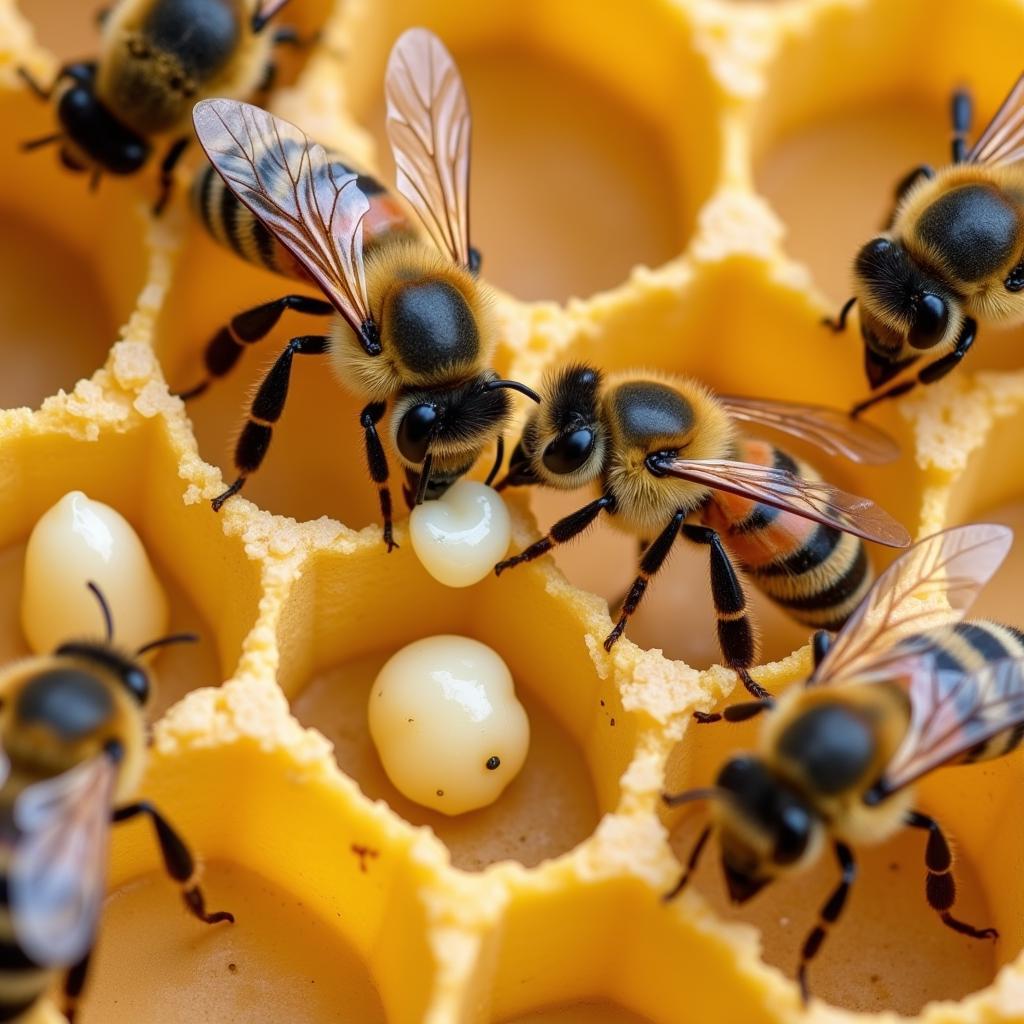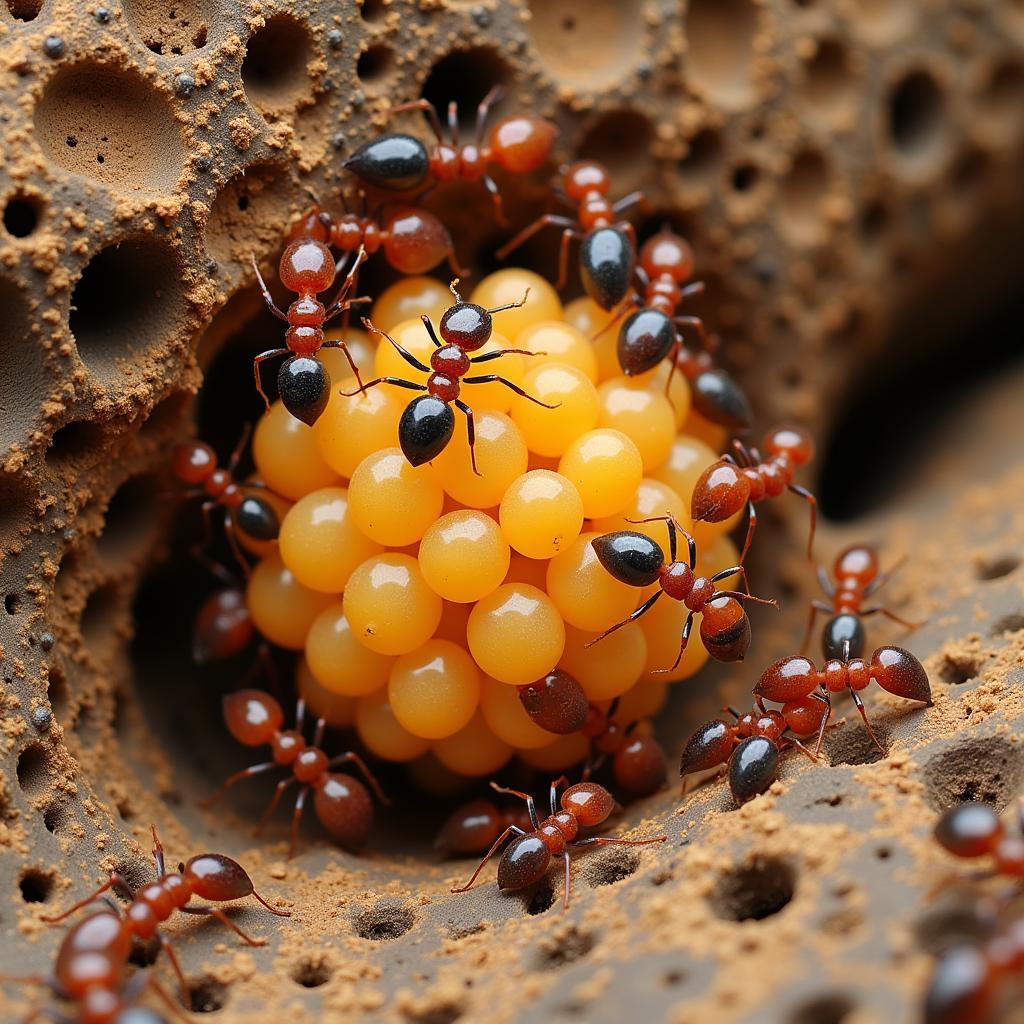Brood Food is essential for the healthy development of young animals, particularly in social insects like bees and ants. It’s a protein-rich substance secreted by worker insects and fed to larvae, playing a crucial role in their growth and metamorphosis. This article delves into the fascinating world of brood food, exploring its composition, significance, and variations across different species. We’ll also examine its crucial role in maintaining healthy colonies and ensuring the survival of future generations.
What is Brood Food and Why is it Important?
Brood food is a vital nutritional component for the growth and development of immature insects. Its importance stems from its rich protein content, essential amino acids, and other vital nutrients that support rapid larval growth and development. Without adequate brood food, larvae might fail to develop properly, resulting in weaker adults or even colony collapse. It’s the foundation of a thriving insect community. Just as chick starter food is vital for young chickens, brood food serves the same purpose for insect larvae. You can see the dedication worker bees have to their young, much like the care taken in creating specific food plots for turkeys to ensure they have the best nutrition.
This essential nourishment, lovingly prepared by worker insects, fuels the growth of the colony’s next generation, ensuring the continuation of the species. This dedication to nurturing the young is a testament to the intricate social structures and cooperative nature of these fascinating insects.
 Brood food being fed to larvae
Brood food being fed to larvae
The Composition of Brood Food: A Nutritional Powerhouse
Brood food’s composition varies between species but typically includes proteins, lipids, carbohydrates, vitamins, and minerals. The precise mix of these nutrients is tailored to the specific needs of each species’ larvae. For example, bee brood food, often referred to as “royal jelly” when fed to queen larvae, is particularly rich in proteins and essential amino acids. This specialized diet allows the queen larva to develop into a fertile adult capable of laying eggs and leading the colony.
Did you know that supplements exist even for bees? Just like we ensure the best nutrition for our young, beekeepers often utilize a honey bee food supplement to support colony health, especially during times of scarcity.
Brood Food in Different Species: Variations on a Theme
While the basic concept of brood food remains consistent across species, there are fascinating variations in its production and composition. Some ant species, for instance, produce a type of brood food that is solid and can be stored for later use. This adaptability allows them to effectively manage resources and ensure the continuous supply of nourishment for their developing young, even during periods of food scarcity. It’s truly remarkable how these tiny creatures have evolved such sophisticated strategies for survival.
Consider Dutch fast food, known for its variety and convenience. Just as there’s a wide array of choices available to humans, the insect world presents a diverse range of brood food, each adapted to the unique needs of the species.
The Role of Brood Food in Colony Health and Survival
Brood food plays a critical role in maintaining colony health and ensuring the survival of insect communities. A healthy brood, well-nourished on a diet of high-quality brood food, translates to a strong and thriving colony. Conversely, inadequate brood food can lead to developmental problems, weaker adults, and increased susceptibility to diseases, potentially jeopardizing the entire colony. Just as we might look to a bee food recipe to ensure the health of our bee colonies, nature provides its own intricate recipes for success.
“Brood food is like the engine of the colony,” says Dr. Amelia Carter, a leading entomologist. “Its quality directly impacts the health and vitality of the next generation, ultimately determining the colony’s fate.”
 Healthy brood in a thriving colony
Healthy brood in a thriving colony
Conclusion: Brood Food – The Lifeline of Insect Societies
Brood food, a nutritional powerhouse, plays an indispensable role in the development, health, and survival of numerous insect species. From the intricate composition tailored to the specific needs of each species to its crucial role in maintaining healthy colonies, brood food exemplifies the remarkable adaptations found in the insect world. Understanding the significance of brood food offers a glimpse into the fascinating complexities of insect societies and underscores the importance of maintaining healthy ecosystems.
FAQ
- What is brood food made of? Brood food is a protein-rich substance containing essential nutrients for larval growth.
- Why is brood food important? It’s crucial for larval development and colony health.
- How does brood food vary between species? Composition and production methods differ based on the specific needs of each species.
- What is royal jelly? Royal jelly is a type of brood food fed to queen bee larvae.
- How does brood food impact colony survival? Adequate brood food ensures strong, healthy adults and a thriving colony.
For any assistance or further questions, please don’t hesitate to contact us. Call us at 02437655121, email us at minacones@gmail.com, or visit us at 3PGH+8R9, ĐT70A, thôn Trung, Bắc Từ Liêm, Hà Nội, Việt Nam. Our customer service team is available 24/7. You might also find our articles on food plots for turkeys and chick starter food interesting.